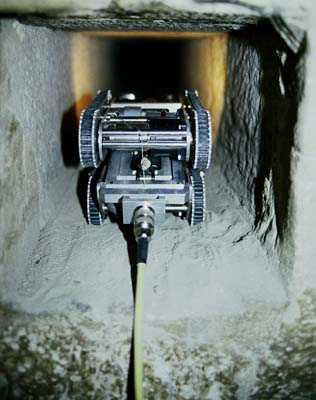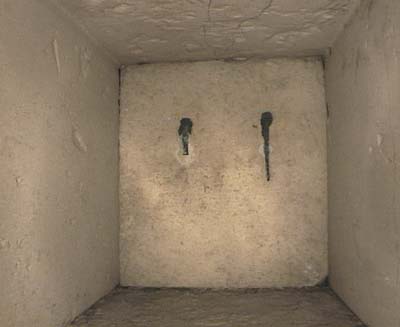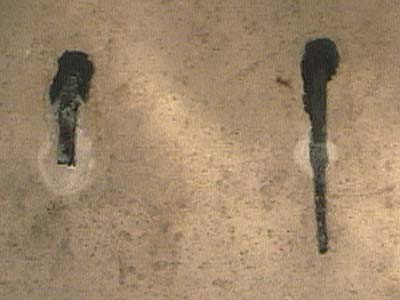|
PREPARING THE THIRD CHEOPS CAMPAIGN
In the late spring of 1992 I'm obsessed with two burning questions: first, where do those lower shafts end? And, of course, what's at the end of them? In fact, it's only the hope of finding answers to these questions that helps me forget the disappointing end to the otherwise very successful second campaign.
So in June I plunge into preparations for the next step. The original project definition foresees investigation of all four shafts, but so far, we have explored only the upper two. We now know the lower ones are not simply "implied", as conventional Egyptology maintains. After all, we've traveled almost 12 meters into both of them, and both obviously continue.
One thing is eminently clear to me at this point – I need a much improved robot!
I begin working out my ideas for "Upuaut-2", and by July I'm completing the computer plans and construction design. In September, actual construction begins, not just on Upuaut-2, but also on the support robot, designed to measure the angle of ascent of the lower shafts, down to one-tenth of a degree. Its clamp gears allow it to ascend by pulling itself upwards along "Upuaut-2's" power cable, so it comes to be known as the "Rope Climber".
Many of the elements I need, especially for Upuaut-2, are very complicated, customized constructions. The gearing, for instance eventually comes from Switzerland.
(see THE ROBOTS page for details)
I learn from my mistake on the first campaign: this time I also build scale models of the shafts so I can conduct extensive trial runs with the new robots. By December 1992 the basic robot Upuaut-2 is completed. The Egyptian Antiquities Organization, the predecessor of today's Supreme Council of Egyptian Antiquities, had asked me to inspect and document the situation of the tomb of Sethos I in the Valley of Kings.
So in December I travel to Egypt again and take advantage of the opportunity to conduct traction tests with the new robot in the lower southern shaft of Cheops.


Ulrich and I performing the traction test in December 1992, inside the
Queens Chamber.
While in Cairo I also show the new robot and slides taken during the second campaign to Dr. Hawass and Prof. Stadelmann. The latter says it's a great pity we have no video documentation of the earlier efforts. I suggest bringing along a small documentary camera team for the upcoming third campaign and Prof. Stadelmann wholeheartedly agrees.
In January 1993 I return to Germany to complete work on Upuaut-2 and the Rope Climber, and to finalize preparations for our third campaign.
THE THIRD CHEOPS CAMPAIGN (March 6th – 28th, 1993)
March 6th
I arrive in Cairo, together with my camera team.
March 7th
I spend the day taking care of general preparations and getting acclimatized again. Am scheduled to meet tomorrow with Dr. Hawass and Prof. Stadelmann.
March 8th
Upuaut-2 and the Rope Climber arrive at the offices of the GAI in Cairo. I go to meet Dr. Hawass, but there is no sign of Prof. Stadelmann. And I find out that not all of the required paperwork has been taken care of. Dr. Hawass knows about our project and plans, but is of course quite unhappy about this lack of proper preparation. He could easily tell us to turn around and go home again. But, in order not to endanger the campaign, he bends over backwards to cut red tape. He requests Ulrich Kapp to inform the GAI that the necessary paperwork must be submitted as soon as possible and generously allows us to proceed.

Moving in!
7 yellow boxes stuffed with electronics just for one little robot.
March 9th
We transport all the equipment to Cheops. Once we get into the Queen's Chamber  , we set up, check out Upuaut-2 and the video system and finally – the campaign gets rolling. But after only a few minutes, we are again thwarted by an unexpected problem. , we set up, check out Upuaut-2 and the video system and finally – the campaign gets rolling. But after only a few minutes, we are again thwarted by an unexpected problem.
Because of the difficulties encountered on the last campaign – not being able to get through the shafts which in one of two places are only 11 cm high, I cut down the height of Upuaut-2 as much as I could. Now I discover I have been slightly too thorough. Right after the start of the lower southern shaft  , we run into one block which turns out to be highest in the entire pyramid. Upuaut-2's upper carriage barely reaches the shaft ceiling at this point, so it has insufficient traction! We try to push it past the block, but don't have a rod or pole long enough to reach into the shaft that far. , we run into one block which turns out to be highest in the entire pyramid. Upuaut-2's upper carriage barely reaches the shaft ceiling at this point, so it has insufficient traction! We try to push it past the block, but don't have a rod or pole long enough to reach into the shaft that far.

Upuaut-2 crawling for the first time into the horizontal
beginning of the lower southern shaft. We had no idea
that this journey would last just two meters.
We give up on the southern shaft and make our first run into the lower northern shaft  , again reaching the rod left behind by an earlier expedition, before we have to call it quits for the day. , again reaching the rod left behind by an earlier expedition, before we have to call it quits for the day.
I initiate my practice of making daily progress reports by telephone to Prof. Stadelmann to keep him informed of what's going on. We spend the rest of the day constructing long push-slats to move the robot past the block with the high ceiling.
March 10th
The push slats do the job! Once past the high-ceiling block, Upuaut again gains traction and we penetrate into the shaft up to 22.5 meters – where we run into the first of what will be many major obstacles. Once again we are stalled. For the first and only time during this campaign, Prof. Stadelmann pays us a short visit.
March 11th
For the first time we send the Rope Climber robot up the shaft to measure the exact angle of ascent. It pulls its way upward along Upuaut-2's power cable.
(see THE ROBOTS page for details)
But before long the Rope Climber's main v-belt, which is made of plastic, begins to melt, due to overheating.
We have to back both robots down out of the shaft, and during this tricky maneuver Upuaut gets stuck. After several attempts to free it up I have no choice but to lower the upper traction carriage, thus reducing the overall height of the unit. But as soon as the robot gets past the obstruction, it no longer has contact with the ceiling and both it and the Rope Climber come crashing down the shaft. The damage is not too severe, but we lose the camera-panning gear and a lamp reflector.
We also discover that we have a problem with our video equipment, which is highly susceptible to dust – and there's no lack of that. In playback mode we're experiencing some pretty serious dropouts.
March 12th
I spend a large part of the day making the necessary repairs to Upuaut-2. Since I have to take the entire robot apart anyway, I decide to outfit it with a new set of specially-manufactured gears which are much more stable.
At Cheops we re-survey the exterior of the pyramid to pinpoint the potential outlet of the lower southern shaft.  Based on the angle measurements we made yesterday, we know that if the shaft does penetrate to the outside, it should do so exactly at the 90th layer. But as in the year before there is no sign of any possible outlet. Based on the angle measurements we made yesterday, we know that if the shaft does penetrate to the outside, it should do so exactly at the 90th layer. But as in the year before there is no sign of any possible outlet.
March 13th
More headaches. We decide to construct guide rods which we can attach to the sides of the robot, to help prevent it from getting stuck in bends of the shaft. But in order to attach them, we require simple M3 screws and nuts. Unfortunately, we don't have any. I spend a large part of the day driving around Cairo in search of these two-bit items, with no luck. Back at the Mövenpick hotel, I ask if someone there could give me a tip about where to find such items. Within minutes I'm shown into the hotel's own workshop – it's a dream come true! Everything we need – tools, equipment – and a nice supply of nuts and bolts in all sizes.
We finally attach the guide rods to the robot, then realize they're probably too long. We remove them, cut down the rods and refit them. I also repair the rear winch by inserting a tension spring to reduce slack.
March 14th
The changes make a big difference in performance – today we manage to ascend 30 meters. But then we run into a lateral block displacement of about 4 cm, which forces the robot sideways against the wall. It turns out that the shorter guide rods we attached yesterday are now too short! The danger is too great that if we simply proceed, we won't be able to back out again. We leave the robot where it is in the shaft and stop for the day.

The lateral displacement at 30 meters.
You can see an original red marking line drawn by the builders.
This narrow passage is only 5 mm wider than Upuaut-2.
March 15th
First thing today we very carefully back the robot all the way down the shaft. We construct longer rods made of aluminum and again spend most of the day searching for tools.
March 16th
While modifications are being made, we do our filming of the exterior of the pyramid.
March 17th
The modified Upuaut proceeds 42 meters up into the shaft.
March 18th
We make it all the way up to 53 meters, then encounter a 6 cm "step" in the floor. In a shaft measuring about 20 by 20 cm, and for a robot less than 11 cm tall, it's like running into a tank trap.

The "tank trap".
The shaft floor was not built this way - the floor broke at some later
date due to static forces. The step is simply the abutting edge of
the next block, which is still intact.
On the "horizon" ahead of us we notice a change in the appearance of the shaft. (This is visible only on the original video material.) I decide to stop at this point and prepare the Rope Climber to ascend and measure the exact angle up to this point.
Today I have to put my foot down. At the start, we were accompanied in the small Queen's Chamber by one inspector. As we penetrate ever farther into the hidden recesses of the pyramid, the excitement and suspense are growing, so we are soon joined by two inspectors, then three, then by their wives and friends. Today the chamber is jammed with visitors and my team can hardly move. I announce that the number of visitors must be limited to six per day.
I pass by the Inspectorate and show a tape of our progress to Dr. Hawass, who is fascinated.
March 19th
Ulrich Kapp, the GAI surveyor who has assisted me so far, is no longer part of the team! Without any warning he has been seen off to upper Egypt on some other assignment.
Once again the v-belt of the Rope Climber goes soft from overheating. I back Upuaut up 11 meters, then extract the Rope Climber, all of which consumes a lot of time. Finally I send Upuaut back up to 53 meters and spend the rest of the day trying to maneuver it over the "step" in the floor. I leave the robot in place and retire to the hotel, plotting a way over this maddening obstacle. I realize that I need more traction on the upper carriage.
March 20th
To the upper drive wheels I need to attach a milled extension with sharper teeth in order increase traction on the ceiling. The "step" is the only spot where we need extreme traction – Upuaut has to climb vertically over the step, dragging 57 meters of cable behind it. I don't have the kind of equipment I need to do the job, but I get lucky. At the hotel I run into some members of a crew who are assembling a cigarette production line in Cairo and they offer to help out.
March 21st
I have to back Upuaut all the way down to the opening to make the necessary changes to the upper carriage and add new lateral guide rods, this time made of stainless steel.
During my daily telephone report to Prof. Stadelmann I receive shocking news – because of internal problems at the EAO, Dr. Hawass resigned from his post yesterday evening! The rumors are flying, but for the moment no one seems to know what the consequences may be. (The same problems would lead to dissolution of the EAO and its replacement by the SCA. After the restructuring, Dr. Hawass would later return to his post as director.)
March 22nd
I send Upuaut back up the shaft to the step at 53 meters. Finally, on the third attempt, the robot clears the hurdle and can proceed. The next six meters of the shaft show a gradual improvement in the quality of workmanship.
At 11.05 a.m., at 59 meters, Upuaut-2 approaches a stone slab, which blocks the shaft!

The stone slab blocking the lower southern shaft. 
This explains the odd change in appearance we noted back on the 18th, as we advanced to the step. What we were seeing was a reflection of this slab.
In our video inspection of all four shafts so far, a total of about 180 meters, we have seen only blocks made of local limestone. But the final block before the slab is definitely carved from lighter-colored limestone, probably originating from the Mocatam Mountains about 30 km from the Giza Plateau, on the other side of the Nile. This was the material the builders used for the higher-quality casing stones of the pyramid's exterior, and for the chamber systems. The workmanship of the last block in front of the slab is also much higher than anything we have seen in any of the shafts so far.
As we approach the slab, we can see two dark streaks on it, which upon closer inspection turn out to be copper fittings. And there is something else. The face of the inspector sitting next to me at the monitor has become chalk white. He draws my attention to two round, white marks on the copper fittings.

The two round, white marks on the copper fittings in close up.
(see THE FINDINGS page for more details)
"These are seals, these are seals!" he exclaims, visibly shaken. "We must stop work immediately and inform our chairman."
The excitement in the Queen's Chamber is palpable. For a variety of reasons, we know we have discovered something of great significance. But I have no choice. I leave Upuaut-2 parked in front of the slab, and we retire to our hotel in Cairo. I call Prof. Stadelmann to give him the news.

A historical moment.
The Inspector Mohammed Sheeha and I half an hour after the find
of the stone slab. We are waiting for Prof. Stadelmann and Dr. Zahi
Hawass to come to the Mövenpick Hotel at Giza.
"Are these really seals? he asks. I simply repeat what the inspector said, adding that I myself have no idea what Old Kingdom seals look like. Within an hour, both Prof. Stadelmann and Dr. Hawass arrive at the hotel.
Together we view the video of the day's discoveries. About the seals, Prof. Stadelmann is quite adamant. He says no such round seals were ever used in the Old Kingdom. But much later, together with a German Egyptologist, I was to investigate this issue more thoroughly and discover that this is not necessarily true. The usual practice in the Old Kingdom was to roll a cylindrical stamp over a piece of clay to create a so-called roll seal.
But not always. Although very little is actually known about the appearance of Old Kingdom seals, it appears that some were indeed made of white gypsum. And careful scrutiny of our video images from the shaft reveals several bits of gypsum in the sand some 15 to 20 meters below the stone slab.
In any case, on this momentous March afternoon in Cairo, both Prof. Stadelmann and Dr. Hawass are absolutely delighted and very complimentary. Prof. Stadelmann says my team and I should prepare a press statement on our findings and Dr. Hawass adds that the Minister of Culture has to be informed immediately.
March 23rd
As every morning, the first thing I do upon reaching the Queen's chamber is turn on Upuaut's video system. During those suspenseful moments before the first image from Upuaut's camera appears on the monitor, I say "good morning" to Upuaut.
This has become a popular custom with everyone present, so today, there is a true chorus of good mornings. Unfortunately, no one representing the GAI is present, but there are representatives of the Inspectorate.
Today we make a more thorough video inspection of that marvelous slab. Subsequently it has come to be known, perhaps unfortunately, as "The Door". This popular name of course implies that the slab actually serves the function of a door, leading to – well, who knows what? But until we can peer behind it, or perhaps even open it, we will never know for sure what it really is and what it meant to the builders of Cheops. So for the time being, it might be more appropriate to refer to it simply as the "USO" – the Unidentified Stone Object.
I back Upuaut out of the shaft and we use the rest of the day to continue our investigation of the lower northern shaft  . I send the robot up to the metal rod we have seen before, then farther along the rod until we reach a sharp bend at 18 meters. I leave it at that and extract the robot from the shaft.
(See THE FINDINGS page for an image of the bend) . I send the robot up to the metal rod we have seen before, then farther along the rod until we reach a sharp bend at 18 meters. I leave it at that and extract the robot from the shaft.
(See THE FINDINGS page for an image of the bend)
March 24th
I spend most of the day preparing the Rope Climber for a trip up the lower northern shaft. During our daily telephone conversation, Prof. Stadelmann proves to be unhappy with the draft of the press statement and requests a re-write.
March 25th
I send Upuaut-2 and the Rope Climber up the lower northern shaft  , to measure the exact angle of ascent and more closely inspect that rod. The temptation is great to send Upuaut around the sharp bend at 18 meters. But, since our short guide rods have suddenly turned up missing, the danger is too great that the robot might get stuck and not be able to return. , to measure the exact angle of ascent and more closely inspect that rod. The temptation is great to send Upuaut around the sharp bend at 18 meters. But, since our short guide rods have suddenly turned up missing, the danger is too great that the robot might get stuck and not be able to return.
I extract both robots, we do a thoroughly clean-up of the Queen's Chamber, pack up all our equipment and leave Cheops. During my daily telephone to report to Prof. Stadelmann, I notice that he seems nervous and worried. And he wants yet another version of our press statement.
March 26th
We transfer all the equipment to the GAI, so it can be sent back to Germany. During dinner, Prof. Stadelmann again proves to be unhappy with the draft press statement. More changes.
March 27th
We draft yet another statement for the press, but Prof. Stadelmann is still dissatisfied. He now says we shouldn't publish anything until May, or perhaps even November, when our next campaign would presumably begin.
March 28th
Thoroughly discouraged by this reaction to our discoveries, I send a fax to the GAI announcing my withdrawal from our "joint project" and fly home to Munich.
THE UPUAUT STORY THE FIRST 1992 CAMPAIGN THE SECOND 1992 CAMPAIGN
|
![]() navigation button
navigation button









